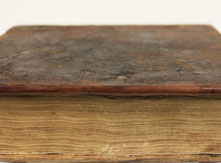Adopt-a-Book
An Initiative of the Friends of the University of Adelaide Library
Speculum mundi. Or, a glasse representing the face of the world: Shewing both that it did begin, and must also end: The manner how, and time when, being largely examined. The whole of which may be fitly called an hexameron. Or discourse of the clauses, continuance, and qualities of things in nature, occasioned as matter pertinent to the work done in the six dayes of the worlds creation.
John Swan (d. 1671)
London: Printed by R. Davenport, for John Williams, 1665
Rare Books & Special Collections
Strong Room Collection SR 501 S97.3
We thank our donor...
Conservation treatment of Speculum Mundi... was generously funded by Adopt-a-Book donor, Barbara Kidman. Her valued contribution has ensured this 17th century encyclopaedia will be available for future generations of researchers for many years to come.
Synopsis
Baptised in September 1605 at Ickleton just south of Cambridge, John Swan was the eldest son of John Swan (d. 1639). His father was the vicar of Sawston, a neighbouring village, between 1600 and 1639 and his mother, Sarah, was the daughter of Thomas Adams, of Wisbech in the far north-east of Cambridgeshire. Following in his father’s footsteps, Swan commenced studies at Trinity College in 1622, graduating BA in 1626 and MA in 1629. That year he was also ordained deacon and priest at Peterborough and appears to have been minister in Duxford St Peter, Cambridgeshire in 1630. Four years later Swan married Frances Rudland and, after her death in 1667, married again. His second marriage to ‘Ellen’ or ‘Helen’ Rudland, likely of the same family, took place at Pampisford, a small village in the south of the county.
With respected English astrologer John Booker amongst his friends, Swan himself had a keen interest in natural and judicial astrology and went to great lengths to defend it in the sermon Signa coeli: the Signs of Heaven (1652), preached the day before ‘Black Monday’, the solar eclipse of 29 March 1652. He also published a chronology of the ancient world, Calamus mensurans: the measuring reed, or the standard of time, containing an exact computation of the yeares of the world… (1653) and completed a series of annually published almanacs from 1657 until 1670.
The first edition of Swan’s encyclopaedia, Speculum Mundi, was published in 1635. Dedicated to the duke of Lennox, a peer at Trinity who shared the same tutor, the work was loosely based on Première semaine, ou, Création du monde (The week, of creation of the world) by French poet Guillaume de Saluste du Bartas. This hexameral poem consisted of seven ‘jours’, each devoted to an aspect of the world created on that day in the first week. Similar in format, Swan organised the content of Speculum Mundi around the six days of creation and focused on cosmology, mineralogy, meteorology, zoology and botany. Though traditionalist in its nature, the work does reveal an inquiring spirit and a genuine interest in recent discoveries and discussions. Its nine chapters are eloquently written and cover topics such as the world’s beginning, the creation of light, the “waters above the heavens”, the qualities of the air, the “fiery meteors”, thunder and lightning, colours of the clouds, the suns and moons, the “ebbing and flowing of the sea”, the height of the stars, the names of fish and fowls, plus the creation of man, amongst many others.
Adapted from the Oxford Dictionary of National Biography entry by Bernard Capp, Oxford University Press, 2004.
Original Condition
Both front and rear boards detached. Front endpaper also detached. Significant loss of leather to cover, board edges and to head and tail of spine, exposing both headbands. Board corners separating and in need of consolidation. Requires rebacking.
 |
 |
 |
 |
 |
 |
Restoration by Anthony Zammit
Item partially rebacked with new calfskin, sympathetic in colour to the old, placed at the head and tail of spine. Remaining spine leather re-adhered to new leather and outer joints reinforced with custom-dyed Japanese repair paper. Front and rear hinges also strengthened with Japanese paper and endpaper tipped in again. Board corners consolidated and rear board corners and fore-edge re-covered with new calfskin.
 |
 |
 |
 |
 |
 |




